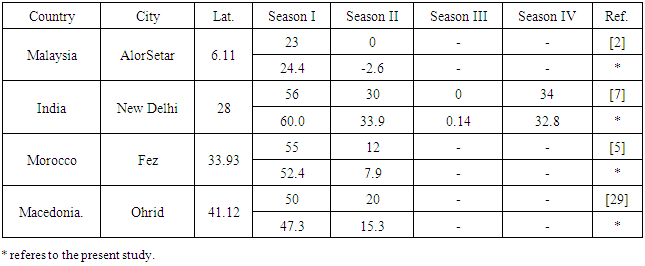| [1] | Feng-Jiao Liu, Tian-Pau Chang, Optimizing the Tilt Angle of Solar Collector under Clear Sky by Particle Swarm Optimization Method, Journal of Applied Science and Engineering, Vol. 18, No. 2, 2015, pp. 167-172. |
| [2] | T. Khatib, A. Mohamed, M. Mahmoud, K. Sopian, Optimization of the Tilt Angle of Solar Panels for Malaysia, Energy Sources, Part A: Recovery, Utilization, and Environmental Effects , Taylor & Francis Group, LLC, 37, 2015, pp. 606–613. |
| [3] | M. Benghanem, Optimization of tilt angle for solar panel: Case study for Madinah, Saudi Arabia, Applied Energy 88, 2011, pp. 1427–1433. |
| [4] | Jasmina Skerlić, Jasna Radulović, Danijela Nikolić, and Milorad Bojić, Maximizing performances of variable tilt flat-plate solar collectors forBelgrade (Serbia), J. Renewable Sustainable Energy 5, 2013, doi: 10.1063/1.4819254. |
| [5] | Belkacem Ihya, Abdellah Mechaqrane, Rachid Tadili, Mohammed Najib Bargach, Optimal tilt angles for solar collectors facing south at Fez city (Morocco), Journal of Natural Sciences Research, Vol.4, No.10, 2014, pp. 120-127. |
| [6] | Felix A. Uba and Emmanuel A. Sarsah, Optimization of tilt angle for solar collectors in WA, Ghana, Advances in Applied Science Research, 4(4), 2013, pp. 108-114. |
| [7] | M. Jamil Ahmad, G.N. Tiwari, Optimization of Tilt Angle for Solar Collector to Receive Maximum Radiation, The Open Renewable Energy Journal, 2, 2009, pp. 19-24. |
| [8] | Dhrupad Sarm, Parimal Bakul Barua, Diganta Hatibaruah, Optimization of Glazing Cover Parameters of a Solar Flat Plate Collector (FPC), International Journal of Engineering Trends and Technology (IJETT) – V. 14 No 2, 2014, pp. 74-80. |
| [9] | Ying-Pin Chang1, Der-An Wang, Optimization of Tilt Angle for Photovoltaic Modules Based on the Neural-Genetic Algorithm, Journal of Nan Kai, Vol.7, No.1, 2010, pp. 57-70. |
| [10] | Jayashri Vajpai Navaneet Maru Model based Optimization of Tilt angle for Solar PV Panels in Jodhpur, International Journal of Computer Applications, 2014, pp. 33-39. |
| [11] | Qais Azzam Khasawneh, Qatada Abdullah Damra, Omaymah Husni Bany Salman, Determining the Optimum Tilt Angle for Solar Applications in Northern Jordan, Jordan Journal of Mechanical and Industrial Engineering, V. 9 No. 3, 2015, pp. 187 - 193. |
| [12] | Arslanoglu A., Optimization of tilt angle for solar collectors: A case study for Bursa, Turkey, International Journal of Electrical, Computer, Energetic, Electronic and Communication Engineering Vol:10, No:5, 2016, pp. 517-520. |
| [13] | Hasan M.S., Optimization of surface orientation angles to receive maximum solar radiation at Sebha city in Libya, M.SC. thesis, Sebelas Maret University, Surakarta, 2015. |
| [14] | Nassar Y.F., Simulation of solar tracking systems, Energy & Life Journal, No 21, March 2005, pp. 81-90. |
| [15] | EL-Kassa by, M.M., Monthly and daily optimum tilt angle for south facing solar collectors; theoretical model, experimental and empirical correlations. Solar & Wind Technology 5, 1988, pp. 589–596. |
| [16] | Soulayman, S.S., On the optimum tilt of solar absorber plates. Renewable Energy 1, 1991, pp. 551–554. |
| [17] | Ibrahim, D., Optimum tilt angle for solar collectors used in Cyprus. Renewable Energy 6, 1995, pp. 813–819. |
| [18] | Elsayed, M.M., Optimum orientation of absorber plates. Solar Energy 42, 1998, pp. 89–102. |
| [19] | Gunerhan, H., Hepbasli, A., Determination of the optimum tilt angle of solar collectors for building applications. Building and Environment 42, 2007, pp. 779–783. |
| [20] | H. P. Garg, Treatise on solar Energy, vol. 1, Fundamentals of solar energy, New York, Willy, 1983. |
| [21] | Hussein, H.E.-G.H.M.S., Ahmad, G.E., Performance evaluation of photovoltaic modules at different tilt angles and orientations. Energy Conversation and Management 45, 2004, pp. 2441–2452. |
| [22] | Duffie J. A. and Beckman W. A., Solar Engineering of Thermal Processes, 3ed., John Wiley & Sons, Inc., 2006. |
| [23] | Nassar Y. F., Solar energy engineering active applications, Sebha University, Libya, 2006. "Arabic language". |
| [24] | Hassane Darhmaoui, Driss Lahjouji, Latitude Based Model for Tilt Angle Optimization for Solar Collectors in the Mediterranean Region, Science Direct, Energy Procedia 42, 2013, pp. 426 – 435. |
| [25] | Khai Mun Ng, Nor Mariah Adam, Othman Inayatullah, Mohd Zainal Abidin Ab. Kadir, Assessment of solar radiation on diversely oriented surfaces and optimum tilts for solar absorbers in Malaysian tropical latitude, Int. J. Energy Environ. Eng., 2014, 5:75. |
| [26] | Yueren Wang, Chenfei Bi, Wen Lou, Yueren Wang, Chenfei Bi, Wen Lou, Collector solar hot water installation angle optimization in severe cold area, International Conference on Applied Science and Engineering Innovation (ASEI 2015). |
| [27] | Ioannis M. Michaelides, Computer simulation and optimisation of solar heating systems for Cyprus, PhD thesis, Faculty of Engineering and Science, Westminster Research http://www.westminster.ac.uk /west minster research, 1993. |
| [28] | Y. N. Udoakah1, N. I. Okpura, Determination of optimal tilt angle for maximum solar insolation for pv systems in Enugu-southern Nigeria, Nigerian journal of technology, vol. 34 no. 4, 2015, pp. 838 – 843. |
| [29] | Igor Shesho, Done Tashevski, Developing simulation application using graphical programming language for optimization of solar collector position, Mechanical Engineering – Scientific Journal, Vol. 31, No. 1–2, 2013, pp. 63-75. |
| [30] | Z. Bouhssine1, M. Faraji1, M. Najam1 and M. El Alami, Numerical Investigations of an Integrated Phase-Change-Material Solar Collector, Tech Science Press FDMP, vol.11, no.1, 2015, pp. 63-85. |
| [31] | Adnan Shariah, M-Ali Al-Akhras, I.A. Al-Omari, Optimizing the tilt angle of solar collectors, Renewable Energy 26, 2002, pp. 587–598. |
| [32] | Shaoning Wang, Bo Hong, Optimum Design of Tilt Angle and Horizontal Direction of Solar Collectors under Obstacle’s Shadow for Building Applications, Journal of Building Construction and Planning Research, 3, 2015, pp. 60-67. |
| [33] | Jože Rakovec, Klemen Zakšek, Kristijan Brecl, Orientation and Tilt Dependence of a Fixed PV Array Energy Yield Based on Measurements of Solar Energy and Ground Albedo – a Case Study of Slovenia, Energy Management Systems, 2011, pp.145-160. www.intechopen.com. |
| [34] | S. Armstrong, W.G. Hurley, A new methodology to optimise solar energy extraction under cloudy conditions, Renewable Energy 35, 2010, pp. 780–787. |
| [35] | Ahmad Qasaimeh, Solar Energy Optimization through Seasons: Case Study in Jordan, Smart Grid and Renewable Energy, 3, 2012, pp. 275-281. www.SciRP.org/journal/sgre. |
| [36] | Fawaz Sultan, Firas Aziz Ali, Tariq Khalid A. Razaq, Tilt Angle Optimization of Solar Collectors for Maximum Radiation in Three Iraqi cities, International Journal of Engineering and Industries (IJEI),Volume3, no 4, December 2012, pp. 99-107. |
| [37] | NASA surface meteorology and solar energy - available tables. https://eosweb.larc.nasa.gov/cgi-bin/see/grid.cgi? |



 by searching for the maximum total solar radiation on the collector surface. In reference to a specific period of time and purpose, daily, monthly, seasonally or yearly values have been calculated [15-17]. Elsayed in [18] also presented an analytical model based on long-term averaging of solar data. He outlined values of optimum tilt angles given in different literature and conducted that value of tilt angle that can be recommended.In fact there is a wide range of tilt (±20) which is dependent on the applied model and the location. Some authors noted the existence of a correlation between the optimum tilt angle and the latitude. Frequently, it is recommended to apply the rule of thumb, in which the yearly optimum tilt angle is about
by searching for the maximum total solar radiation on the collector surface. In reference to a specific period of time and purpose, daily, monthly, seasonally or yearly values have been calculated [15-17]. Elsayed in [18] also presented an analytical model based on long-term averaging of solar data. He outlined values of optimum tilt angles given in different literature and conducted that value of tilt angle that can be recommended.In fact there is a wide range of tilt (±20) which is dependent on the applied model and the location. Some authors noted the existence of a correlation between the optimum tilt angle and the latitude. Frequently, it is recommended to apply the rule of thumb, in which the yearly optimum tilt angle is about  (L: latitude) and a difference of tilt with about 10° would hardly affect the performance. Authors of [19] determined monthly optimum tilt angles for Izmir, Turkey; they found the optimum tilt angle
(L: latitude) and a difference of tilt with about 10° would hardly affect the performance. Authors of [19] determined monthly optimum tilt angles for Izmir, Turkey; they found the optimum tilt angle  to be equal to U throughout the year, while for summer
to be equal to U throughout the year, while for summer  and for winter
and for winter  was suggested, these values were suggested also by [20]. They advised to mount the solar collector at the monthly average tilt angle. During the last decade there have also been investigations by using simulation software. This software which was developed in order to simulate an entire solar power plant, takes the most influential parameters into account. The soft ware usually possesses a database of monthly mean global radiation data and different empirical models: for example authors of [21] applied the simulation software TRNSYS to calculate the optimum tilt angle for Cairo, Egypt. What they did was calculating the monthly mean of solar radiation data and compared it with the output power of solar cells. They stated the yearly optimum tilt angle to be
was suggested, these values were suggested also by [20]. They advised to mount the solar collector at the monthly average tilt angle. During the last decade there have also been investigations by using simulation software. This software which was developed in order to simulate an entire solar power plant, takes the most influential parameters into account. The soft ware usually possesses a database of monthly mean global radiation data and different empirical models: for example authors of [21] applied the simulation software TRNSYS to calculate the optimum tilt angle for Cairo, Egypt. What they did was calculating the monthly mean of solar radiation data and compared it with the output power of solar cells. They stated the yearly optimum tilt angle to be 
 hourly beam radiation
hourly beam radiation  hourly diffuse radiation
hourly diffuse radiation  and hourly reflect radiation
and hourly reflect radiation  on the inclined surface on a clear day are calculated using the following expression:
on the inclined surface on a clear day are calculated using the following expression:



 is the beam normal radiation
is the beam normal radiation  A is the apparent solar-radiation constant in
A is the apparent solar-radiation constant in  B is the atmospheric extinction coefficient, and C is the diffuse sky factor and there values are tabulated in table 1 for a widely range of latitudes
B is the atmospheric extinction coefficient, and C is the diffuse sky factor and there values are tabulated in table 1 for a widely range of latitudes 
 and
and  are coefficients and
are coefficients and  is ground Albedo and was assumed to be 0.5. is the ratio between global solar energy on a horizontal surface and global solar energy on a tilt surface. Meanwhile,
is ground Albedo and was assumed to be 0.5. is the ratio between global solar energy on a horizontal surface and global solar energy on a tilt surface. Meanwhile,  is the view factor between the sky and the tilt surface and
is the view factor between the sky and the tilt surface and  is the view factor between the ground and the surface that tilted at angle
is the view factor between the ground and the surface that tilted at angle  from the horizontal. These coefficients evaluated from:
from the horizontal. These coefficients evaluated from:


 is the solar incident angle and it is given by:
is the solar incident angle and it is given by: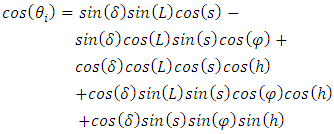
 is latitude, the angular location north or south of the equator, north positive;
is latitude, the angular location north or south of the equator, north positive;
 slope of the surface;
slope of the surface;  is the surface azimuth angle, with zero due south, east negative, west positive,
is the surface azimuth angle, with zero due south, east negative, west positive, 
 is the hour angle,
is the hour angle,  morning negative, zero at noon and afternoon positive; and
morning negative, zero at noon and afternoon positive; and  is solar declination angle, it can be found from:
is solar declination angle, it can be found from:
 is the Julian day. Meanwhile,
is the Julian day. Meanwhile,  is the solar zenith angle, which equal to:
is the solar zenith angle, which equal to:
 The surface azimuth
The surface azimuth  is either
is either  for south facing or
for south facing or  for north facing. In regard to the daily optimization, the basis is the daily total hourly radiation, for the monthly optimization the basis is the monthly total daily and for annual optimization the basis is the annual total monthly.It is well known that a unique surface tilt angle which exists for each time, and which corresponds to each latitude angle
for north facing. In regard to the daily optimization, the basis is the daily total hourly radiation, for the monthly optimization the basis is the monthly total daily and for annual optimization the basis is the annual total monthly.It is well known that a unique surface tilt angle which exists for each time, and which corresponds to each latitude angle  for a particular day
for a particular day  through which the solar radiation is at peak value. Accordingly, this study enhances these two parameters as independent variables for the daily, monthly, seasonal and annual optimum angle prediction.The seasonal average tilt angle was calculated by finding the average value of the tilt angle for each season, but the implementation of this condition requires the collector tilt to be changed four times a year. The process of adjusting the tilt angle to its monthly optimum values throughout the year does not seem to be practical, and at the same time rises the consideration of changing the tilt angle once seasonal.The obtained results from the FORTRAN program treated by MATLAB in order to get out polynomials those fitted the daily, monthly, seasonal and annual optimum angles. The general form of the polynomial that prescribed the optimum tilt angle is expressed in fifth order three dimension as:
through which the solar radiation is at peak value. Accordingly, this study enhances these two parameters as independent variables for the daily, monthly, seasonal and annual optimum angle prediction.The seasonal average tilt angle was calculated by finding the average value of the tilt angle for each season, but the implementation of this condition requires the collector tilt to be changed four times a year. The process of adjusting the tilt angle to its monthly optimum values throughout the year does not seem to be practical, and at the same time rises the consideration of changing the tilt angle once seasonal.The obtained results from the FORTRAN program treated by MATLAB in order to get out polynomials those fitted the daily, monthly, seasonal and annual optimum angles. The general form of the polynomial that prescribed the optimum tilt angle is expressed in fifth order three dimension as:
 and the variables
and the variables  and
and  are defined below in table 2.
are defined below in table 2.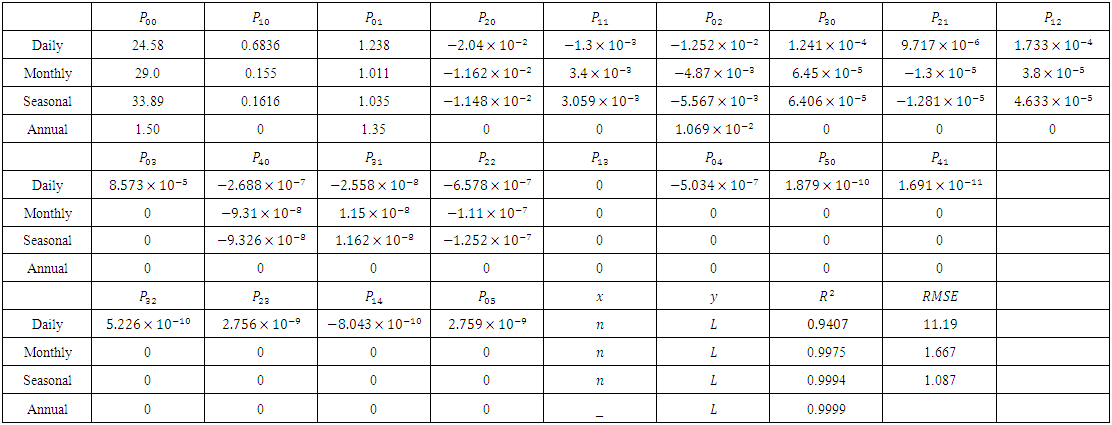
 for a complete calendar year. The abscissa presents the Julian day
for a complete calendar year. The abscissa presents the Julian day  The markets present the calculated results and the dash lines present the daily polynomial. Obviously, depending on figure 1, it can be stated that the polynomial is well fitted to the calculated data. The positive value depicted means that the surface was inclined towards the equator, where as the negative value means that the surface was inclined towards the North Pole. The slopes were within the range of
The markets present the calculated results and the dash lines present the daily polynomial. Obviously, depending on figure 1, it can be stated that the polynomial is well fitted to the calculated data. The positive value depicted means that the surface was inclined towards the equator, where as the negative value means that the surface was inclined towards the North Pole. The slopes were within the range of  for any location on the northern hemisphere.
for any location on the northern hemisphere.
 even in some times better than NASA's data. Unfortunately, for low latitudes
even in some times better than NASA's data. Unfortunately, for low latitudes  the model needs to more arrangements.
the model needs to more arrangements.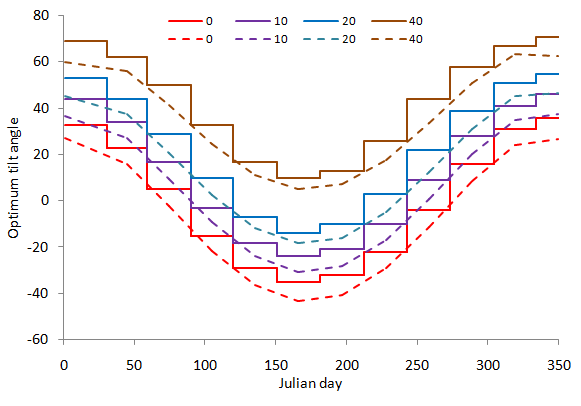
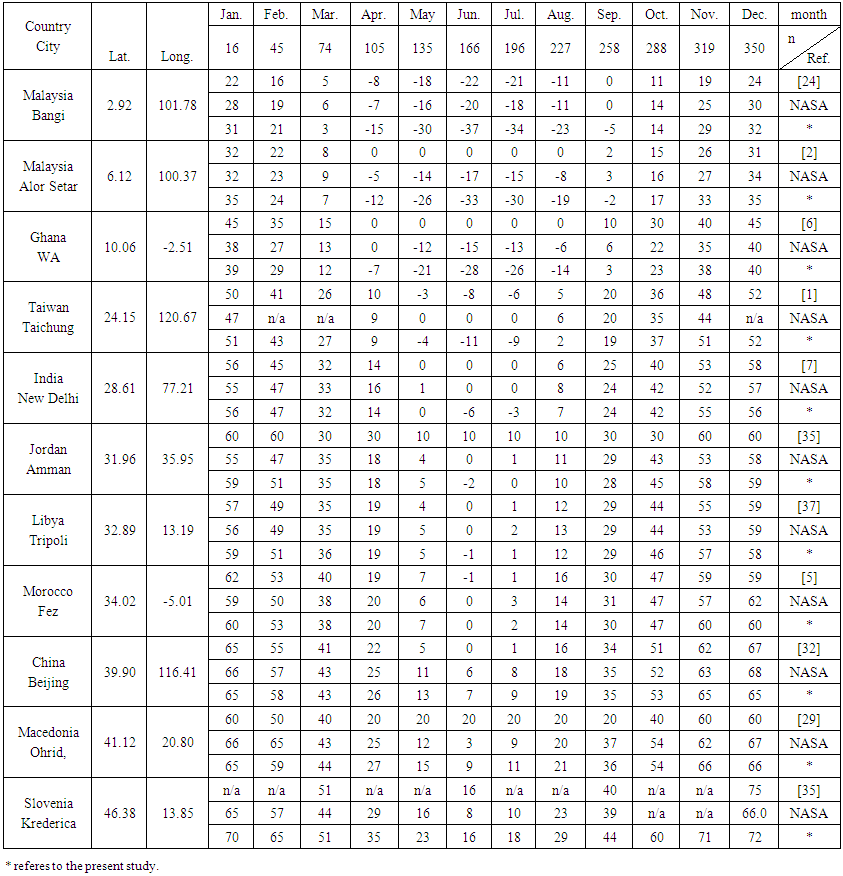
 for both hemispheres for monthly tilt angle optimization, and the optimum tilt angle for southern hemisphere is negative sing of the optimum tilt angle for northern hemisphere for the same latitude.
for both hemispheres for monthly tilt angle optimization, and the optimum tilt angle for southern hemisphere is negative sing of the optimum tilt angle for northern hemisphere for the same latitude.
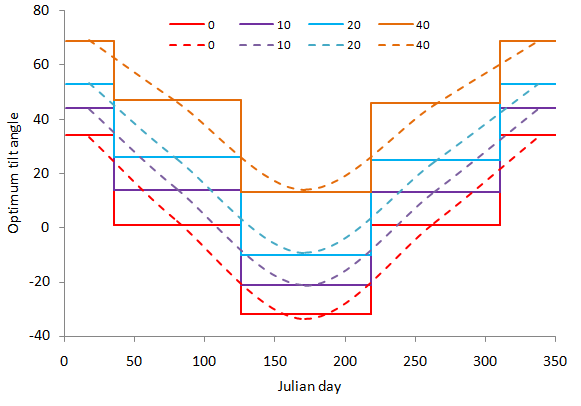
 facing to the south (equator). The value was similar and agreed with the optimum slope presented by other researchers and for those of NASA, specially for high latitudes
facing to the south (equator). The value was similar and agreed with the optimum slope presented by other researchers and for those of NASA, specially for high latitudes  even in some times better than NASA's data. Additionally, the computed results were fairly consistent with the general rule that the yearly optimal tilt angle was about the latitude of the location facing to the equator, specially for middle latitudes. For the southern hemisphere the optimum tilt angle
even in some times better than NASA's data. Additionally, the computed results were fairly consistent with the general rule that the yearly optimal tilt angle was about the latitude of the location facing to the equator, specially for middle latitudes. For the southern hemisphere the optimum tilt angle  will be negative sign of the northern hemisphere
will be negative sign of the northern hemisphere  at the same latitude.
at the same latitude. 
 Abstract
Abstract Reference
Reference Full-Text PDF
Full-Text PDF Full-text HTML
Full-text HTML

